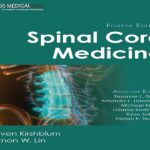- عنوان کتاب: Spinal Cord Medicine
- نویسنده: Steven Kirshblum, Vernon W. Lin
- حوزه: پزشکی نخاع
- سال انتشار: 2026
- تعداد صفحه: 1096
- زبان اصلی: انگلیسی
- نوع فایل: pdf
- حجم فایل: 27.7 مگابایت
نخاع در تونلی که از میان مهرهها عبور میکند، پنهان است. در انسان، این طناب ممکن است قطری معادل ۱۳ میلیمتر یا کمتر داشته باشد و شامل مجموعهای از نورونهای میکروسکوپی است که سیگنالهای الکتریکی را از هر قسمت از بدن به مغز و برعکس منتقل میکنند. با توجه به محل پنهان، اندازه کوچک و عملکرد آناتومیک آن، جای تعجب نیست که برای هزاران سال اطلاعات بسیار کمی در مورد نخاع وجود داشته است. در حالی که آناتومیستها به تدریج در چند صد سال گذشته درک درستی از نخاع پیدا کردند، میتوان شواهدی از آسیبهای نخاعی (SCI) را در دوران باستان یافت. اولین توصیف شناخته شده از آسیبهای نخاعی (SCI) از مجموعهای از کتیبهها است که گمان میرود توسط ایمهوتپ، یکی از برجستهترین معماران و پزشکان فرعون مصر باستان، نوشته شده باشد. این طومارها که به عنوان پاپیروس ادوین اسمیت (شکل ۱.۱) شناخته میشوند، تقریباً به ۱۷۰۰ سال قبل از میلاد مسیح برمیگردند، اما به طور گسترده اعتقاد بر این است که از نوشتههای ایمهوتپ، که در اواخر قرن ۲۷ قبل از میلاد زندگی میکرد، رونویسی شدهاند. ادوین اسمیت، مصرشناس آمریکایی، این پاپیروس را در سال ۱۸۶۲ در اقصر مصر خریداری کرد، اما محتوای آن تا زمان ترجمه توسط جیمز برستد در سال ۱۹۳۰ درک نشده بود. پاپیروس ادوین اسمیت شامل ۴۸ مورد بالینی است که آسیبهای تروماتیک اسکلتی-عضلانی و عصبی را توصیف میکند. بیست و هفت مورد شامل ضربه به سر بود؛ مورد ششم شامل پارگی مننژ بود و اعتقاد بر این است که اولین توصیف مایع مغزی نخاعی است. شش مورد شامل انواع مختلف آسیبهای ستون فقرات گردنی بود. برخی از موارد، آسیبهای گردنی خفیفتری بودند: (الف) زخم باز گردن، همراه با سفتی گردن، که با بستن زخم با گوشت تازه درمان میشد؛ و (ب) رگ به رگ شدن گردن و جابجایی مهرهها، که با بستن با گوشت و استفاده از ymrw، یک ماده معدنی باستانی، و عسل درمان میشد. موارد دیگر را میتوان اولین توصیف از آسیبهای نخاعی واقعی در نظر گرفت: (الف) بیماری با دررفتگی مهرههای گردن و “بیهوشی دو دست و پایش، همراه با چکه کردن ادرار”، که نشان دهنده از دست دادن حسی یا حرکتی اندامهای او و همچنین از دست دادن کنترل مثانه است؛ و (ب) بیماری با مهرههای له شده، که “بیهوشی دست و پا و همچنین بیکلام” میشود، که شبیه آسیب دوگانه نخاع و مغز به نظر میرسد. هر دوی این موارد “بیماریای که نباید درمان شود” در نظر گرفته میشدند، که این انتظار قرنها را ایجاد کرد که بهبود پس از آسیب نخاعی امکانپذیر نیست. آخرین مورد در این مجموعه، پیچ خوردگی مهرهها را مورد بحث قرار میدهد، که در آن بیمار پاهایش را دراز میکند، اما بلافاصله با درد منقبض میشود. به نظر میرسد این اولین توصیف از اسپاسم از یک آسیب نخاعی ناقص است و بیماریای بود که میتوانست درمان شود. جالب اینجاست که درمان با این جمله شروع میشود که بیمار “به پشت دراز میکشد و برای آنها …” دراز میکشد و سپس نوشته ناگهان در وسط یک کلمه تمام میشود. به نظر میرسد که آنها بیش از 4000 سال پیش درمانهایی برای اسپاسم یا آسیبهای نخاعی ناقص داشتهاند، اگرچه ممکن است هرگز ندانیم که آنها چه بودهاند. بقراط، که پدر پزشکی محسوب میشود، تقریباً 500 تا 400 سال قبل از میلاد مسیح، توصیفات دقیقتری از آسیبهای ستون فقرات و نخاع (SCI) در یونان باستان ارائه داد. او آناتومی ستون فقرات را با جزئیات کامل شرح داد و توضیحات دقیقتری از عوارض SCI، از جمله فلج، یبوست، احتباس ادرار، آسیبهای فشاری و لخته شدن خون ارائه داد.2،3 او اولین کسی بود که کشش را برای کمک به کاهش آسیبهای نخاعی و اصلاح ناهنجاریهای ستون فقرات توصیه کرد4 (شکل 1.2). بقراط احساس میکرد که بخش بزرگی از افزایش عوارض و مرگ و میر مربوط به SCI به دلیل مشکلات روده است و یک رژیم غذایی خاص، اساساً یک رژیم غذایی پرفیبر را توصیه کرد. جالینوس، یکی از برجستهترین پزشکان یونانی پس از بقراط، از حدود 130 تا 200 میلادی زندگی میکرد. او کالبدشکافیهای دقیقی از ستون فقرات و نخاع حیوانات انجام داد و مشخص کرد که اعصاب در کجا قرار دارند و چگونه یک قطع نخاع بر عملکرد تأثیر میگذارد. او همچنین برخی از ضایعات نخاعی، مانند سل ستون فقرات را توصیف کرد. تحقیقات او به شکلگیری پایهای برای درک آسیبهای نخاعی (SCI) برای چندین قرن کمک کرد.5 با این حال، در حالی که تلاشها برای درک آناتومی و فیزیولوژی ستون فقرات بهبود یافت، در نهایت آسیبهای نخاعی هنوز قابل درمان تلقی نمیشدند.
Hidden within a tunnel traversing the vertebrae lies the spinal cord. In humans, this cord may be 13 mm in diameter or smaller, comprising a bundle of microscopic neurons shuttling electric signals from every part of the body to the brain and back. Given its concealed location, small size, and anatomic function, it is no wonder that very little was known about the spinal cord for millennia. While anatomists gradually developed an understanding of the spinal cord in the last several hundred years, it is possible to find some acknowledgment of SCIs as far back as ancient times. The first known description of SCI is from a series of inscriptions presumed to be written by Imhotep, one of the most prominent architects and physicians to a pharaoh of Ancient Egypt. These scrolls, known as the Edwin Smith Papyrus (Figure 1.1), date to approximately 1700 Before the Common Era (BCE), but are widely believed to be transcribed from the writings of Imhotep, who lived during the late 27th century BCE. Edwin Smith was an American Egyptologist who purchased the papyrus in Luxor, Egypt in 1862, but its content was not understood until it was translated by James Breasted in 1930. The Edwin Smith Papyrus contains 48 clinical cases describing musculoskeletal and neurologic traumatic injuries. Twenty-seven involved hits to the head; case 6 involved a meningeal rupture and is believed to be the first description of cerebrospinal fluid. Six cases involved a variety of different cervical spine injuries. Some cases were less severe neck injuries: (a) a gaping wound of the neck, with a stiff neck, which was treated by packing the wound with fresh meat; and (b) a sprain of the neck and displaced vertebrae, which was treated by binding with meat, and applying ymrw, an ancient mineral, and honey. Other cases could be considered the first description of true SCIs: (a) a patient with a dislocation of the neck vertebrae and “unconscious of his two arms and legs, with urine dribbling,” suggesting sensory or motor loss of his limbs, as well as loss of bladder control; and (b) a patient with crushed vertebrae, becoming “ unconscious of arms and legs, as well as speechless,” which sounds like a dual spinal cord and brain injury. Both of these cases were considered “an ailment not to be treated,” which initiated a centuries- long expectation that improvement after SCI was not possible. The last case in this series discusses a sprain in the vertebrae, in which the patient would extend out the legs, but would immediately contract with pain; this appears to be the first description of spasticity from an incomplete SCI and was an ailment that could be treated. Intriguingly, the treatment starts by having the patient “lay on their back, and make for them…,” and then the inscription abruptly ends in the middle of a word. It appears that they had treatments for spasticity or incomplete SCIs over 4000 years ago, although we may never know what they were. Hippocrates, considered the Father of Medicine, provided more detailed descriptions of the spine and spinal cord injuries (SCIs) in Ancient Greece approximately 500 to 400 BCE. He described in great detail the anatomy of the spine and provided some more detailed descriptions of SCI sequelae, including paralysis, constipation, urinary retention, pressure injuries, and blood clots.2,3 He was the first to recommend traction to help reduce spinal injuries and correct spinal deformities4 (Figure 1.2). Hippocrates felt a large component of the increased morbidity and mortality related to SCI was due to bowel issues, and recommended a special diet, essentially a high-fiber diet. Galen, one of the most prominent Greek physicians following Hippocrates, lived from about 130 to 200 in the Common Era (CE). He performed detailed dissections of the spine and spinal cord of animals, determining where nerves coursed and how a transection impacted function. He also described some spinal cord lesions, such as tuberculosis of the spine. His research helped form a basis for understanding SCIs for several centuries.5 However, while attempts to understand the anatomy and physiology of the spine improved, ultimately SCIs were still not considered treatable.
این کتاب را میتوانید از لینک زیر بصورت رایگان دانلود کنید:
Download: Spinal Cord Medicine




































نظرات کاربران